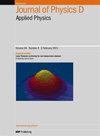Design of systems for plasma activated water (PAW) for agri-food applications
IF 3.2
3区 物理与天体物理
Q2 PHYSICS, APPLIED
引用次数: 0
Abstract
This review explores the engineering and design aspects of plasma activated water (PAW) systems, focusing on their application in food safety and agriculture. This review aims to bridge the gap between research and practical application, paving the way for the development of robust and efficient PAW systems for enhancing food safety and agricultural productivity. By examining a variety of activation methods, including direct gas ionization, underwater discharges, and dynamic interactions of ionized gases with liquids, this work discusses the mechanical designs that facilitate these processes, highlighting their scalability and efficiency. The discussion is grounded in a comprehensive relevant scientific and patent literature, offering a critical overview of the systems’ design parameters that influence the generation of reactive oxygen and nitrogen species (RONS). The designs reported in literature have employed three major approaches, viz. direct underwater discharges, gas ionization followed by introduction of plasma into the liquid, creation of gas liquid mixtures and subsequent ionization. The laboratory systems have relied on natural convective diffusion of the RONS into water, while most of the patents advocate use of forced convective diffusion of RONS to increase transfer rates. Despite widespread laboratory-scale research in PAW, the transition to industrial-scale systems remains underexplored.设计用于农业食品应用的等离子活化水 (PAW) 系统
本综述探讨了等离子体活化水(PAW)系统的工程和设计方面,重点是其在食品安全和农业方面的应用。本综述旨在弥合研究与实际应用之间的差距,为开发稳健高效的等离子活化水系统以提高食品安全和农业生产力铺平道路。通过研究各种活化方法(包括直接气体电离、水下放电以及电离气体与液体的动态相互作用),本论文讨论了促进这些过程的机械设计,并强调了它们的可扩展性和效率。讨论以全面的相关科学和专利文献为基础,对影响活性氧和氮物种(RONS)生成的系统设计参数进行了重要概述。文献中报道的设计采用了三种主要方法,即直接水下放电、气体电离后将等离子体引入液体、产生气液混合物并随后电离。实验室系统依赖于 RONS 向水中的自然对流扩散,而大多数专利则主张使用 RONS 的强制对流扩散来提高传输速率。尽管实验室规模的 PAW 研究十分广泛,但过渡到工业规模系统的研究仍然不足。
本文章由计算机程序翻译,如有差异,请以英文原文为准。
求助全文
约1分钟内获得全文
求助全文
来源期刊
CiteScore
6.80
自引率
8.80%
发文量
835
审稿时长
2.1 months
期刊介绍:
This journal is concerned with all aspects of applied physics research, from biophysics, magnetism, plasmas and semiconductors to the structure and properties of matter.

 求助内容:
求助内容: 应助结果提醒方式:
应助结果提醒方式:


